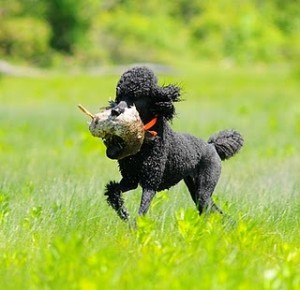Articles in the Dog House Training Category
Dog House Training »
Nuts and bolts of puppy obedience training
Not long after a puppy is born, the puppy respect training can begin. The nuts and bolts of puppy obedience training may be initiated by the breeder from whom you purchased or secured your puppy.
Studies demonstrate that up to the age of three weeks, puppies are not yet ready to take in even a little in the way of instruction. They are not attentive of anything else except for their mom, food, and sleep. During this period, puppy elimination is done by response, but they change around the 21st to 28th day of puppy life as they begin to leave the blanket and search for a place to eliminate. At this period, puppies develop into more aware of their environment and are growing more responsive to stimuli. Lessons that an animal learns at an early age will have a greater impact on their obedience training as a whole.
[caption id="attachment_1640" align="alignright" width="300" caption="Puppy obedience training"] [/caption]
[/caption]
Staying encouraging helps puppies
When you want your dog to do the precise thing, the best thing to do is to not use chastisement as a form of readiness. Spoken praise along with special treats are more valuable. When you are needing to use negative stimuli for your puppy it should be limited to no and block any bad actions from your puppy with using your hands. hitting a puppy or injuring it in any way is and should not be used as a form of chastisement.
Puppies must be rewarded with praises and positive affection each time they react acceptably to a command. If not praised, puppies will lose enthusiasm and interest in obeying you. After your pet does a command properly and you praise and caress them, they will then learn that following these things are enjoyable and pleasing. Puppy obedience will also be developed as he learns that repeating proper events will reap rewards. Praises and treats, when used as positive reinforcement, can enhance the training and encourage the puppy to react to your commands.
Persistence mixed with large timing
While puppy training, you must keep in mind that timing is everything. Details such as actions, movements, and corrections will impinge on the puppy’s skill to follow commands. It is essential that pups gain knowledge of to recognize that the corrections are given as a result of his awkward action and conduct and that it will not happen if only he did what was expected of him.
For instance, a puppy who chews on a toy in a different room may not react to the command “come,” and unless it is reinforced, he will not learn to obey it.He will find out that “come” means that he should head for the trainer and that it will also bring in the goodies if the puppy is told to “come” under controlled situations, like when he’s on a leash and is gently pulled toward the trainer then praised.
Teaching puppy obedience training can be done at home if you focus on one exercise at a time and keep your instructions simple. It’s a whole lot easier to enlist in a training programs that is separated into phases rather than trying to teach your dog everything at once. Bring your patience with you when you are training and use positive reinforcement. Slowly your puppy will be taught to obey.
Photo source:fastpupdogtraining.blogspot.com
















 The
The